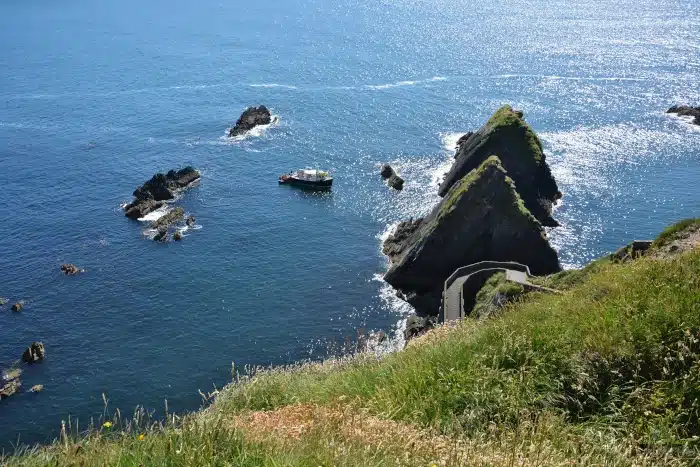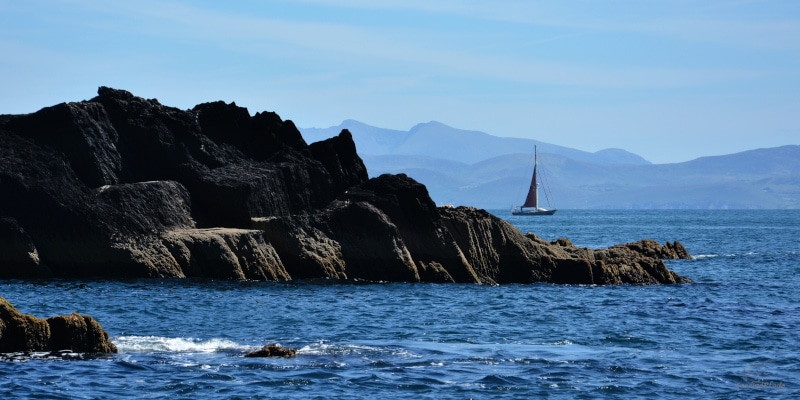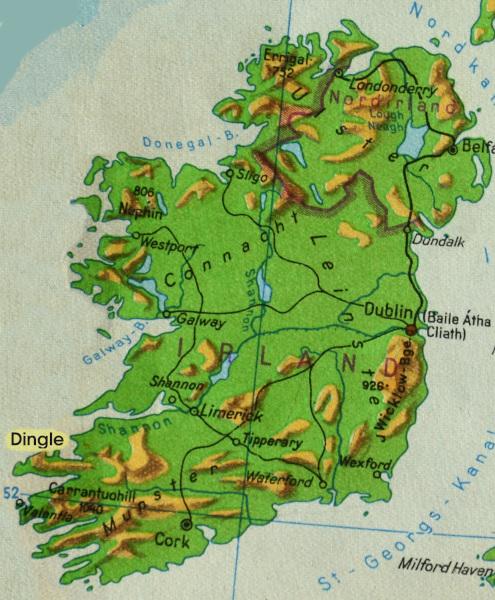
In the southwest of Ireland, where the rough surf of the Atlantic crashes against the rocks of the island, several peninsulas have emerged with their own charm. The northern of the peninsulas is Dingle, part of the „wild atlantic way“ on the west coast of Ireland. A good place and starting point for exploring the peninsula is the small town of Dingle with the same name. With numerous pubs, craft stores and a small fishing harbor, the colorful town caters to visitors. Excursions and hikes are readily available from Dingle.
[Contains *advertisement]
The Dingle Peninsula – varied landscape under Atlantic influence
About 50km long and on average about 9km wide is the peninsula of Dingle, Co. Kerry, with Irish name Corca Dhuibhne, probably after an ancient tribe of the region. The westernmost point Dunmore Head is also the westernmost of the Irish „mainland“ at all. The coastline of Dingle is very rugged and varied – there are shallow beach bays as well as steep rocky cliffs, narrow headlands and deeply cut bays. But even between the coasts, the landscape is diverse. Hills and mountains with meadows and pastures as well as the typical stone walls and field hedges provide a rich structure in the relief, so that a walk on Dingle is never boring.

Hiking on Dingle and discover evidence of Irish prehistory
Hiking is also one of the best activities for visitors to Dingle. Tours lead e.g. to the Connor Pass, the highest pass in Ireland or to the cliff Slea Head in the west of the peninsula. There are also many prehistoric and early historic monuments to be discovered in the landscape such as stone circles, menhirs and dolmens from Celtic times, church ruins or remains of fortified towers such as Dunbek Fort. The westernmost place in Ireland is Dún Chaoin. From there you can take a fishing boat to the offshore Great Blasket Islands.
A famous historical site on the Dingle Peninsula is also the Gallarus Oratory Chapel. This is already about 1200 years old and built without mortar stone on stone like a dry stone wall. Unusual is the shape, which resembles an upside down, so keel-up lying boat.

On Sleahead drive you can also find the so-called Fahan beehive huts. These stone huts were built by hermits as retreats.
The bay of Smerwick was already a port in the Viking Age and served as a transhipment point for goods from the region, but also with the coastal regions of western France and Spain.
A massacre took place here in 1580, when the cruel English Earl of Ormond (called The Black Earl) besieged a Spanish army and killed it with man and mouse. This event marked a turning point for Dingle as a whole, as not only was the previously flourishing trade disrupted, but all crops were destroyed, all villages destroyed and livestock stolen. Another historical sight on the Dingle Peninsula is Dunbeg Fort.

Dingle Town – the small town on the peninsula
The main tourist center of the peninsula is Dingle Town in the south, about halfway between Dunmore Head and the heartland near Tralee. This small town with about 2000 inhabitants is fully geared to tourists with numerous pubs, restaurants and craft stores. Dick Mack’s, for example, is well known, because this place is a pub and a cobbler’s workshop in one with the appropriate odeur.
Whole streets are decorated in the typical Irish colors. However, the small town is often already overcrowded – even the search for a parking space can take quite a while for guests arriving by car. Although there are several large parking lots in the harbor area.

Dolphin and whale watching and maritime adventures
But Dingle is a good starting point for island tours – whether individually and self-organized or with local tour providers. From the harbor, former fishermen also offer boat tours for dolphin – and whale watching* in the bay.
Until 2020, a dolphin was the most famous „inhabitant“ of Dingle Town! The bottlenose dolphin called Fungie probably fell in love with the small town on the peninsula in the mid-80s and remained faithfully as a loner in the bay off the harbor entrance. Daily there were numerous boat tours on the „hunt“ for Fungie, the spectacle attracted a lot of visitors additionally to the town.

And the dolphin played along! Fungie seemed to love to race with the boats and show off his swimming skills to the curious guests. Whether there was secretly somehow helped with fish meals, I can unfortunately not assess. However, Fungie disappeared in October 2020. It is assumed that he died of natural old age, because his age was estimated to be already over 40 years. A small bronze sculpture still reminds of the visitor-magnetizing dolphin in front of the tourist information in Dingle Town. As a „replacement“ there is an Oceanworld Aquarium in Dingle Town.

Fungie was reliable! Whether the whale and dolphin observation – tours allow today also still guaranteed sightings, is rather questionable. But for real nature lovers this should be acceptable. Finally it concerns wild animals and not a zoo with trained monkeys. They don’t always like homo sapiens. A boat trip off the coast* of the Dingle Peninsula is nevertheless certainly a not everyday maritime adventure with diverse impressions, especially encounters with the sea – bird life.

Dingle Town historically – small gate to the wide world
Although Dingle Town Irish: An Daingean or Daingean Uí Chúiserst 1607 received a statute as a city, the history of the village is much longer. The name refers to a fortress, which, however, cannot be attributed to any Irish noble house. There are speculations that in the 13th century a Flemish family settled there and built a fortified house, from whose name the Irish name was derived. Already in the Middle Ages there were probably three towerhouses in Dingle in a very small area. Norman settlers, Flemings and Franks had settled in Dingle and made the port a trading center for fish, meat, hides and wool. Coal, salt and wine were also imported to the Celtic island through Dingle. Trade routes extended as far as France and Spain.
Today, the port of Dingle Town is still mainly a fishing port, but also a recreational port and starting point for boat tours or deep sea fishing adventures. If you want to try deep sea fishing, you can join a 2-hour tour*. If this appeals to you and you would like to experience more fishing adventures in Dingle Bay, you will certainly find suitable contacts for longer fishing ventures among the tour providers.

Dingle as a film stronghold
Even before the discovery of Dingle as a tourist destination at the end of the 60s, the peninsula gained fame as a film set. For months, the film „Ryan’s Daughter“ was shot at various locations on Dingle. The film story is somewhat based on the novella „Madame Bovari“ by the French writer Gustave Flaubert. In terms of content, many critics saw an overstretched rather boring film, but the landscapes delighted audiences even then.
In keeping with the film tradition, there is now an annual Dingle Film Festival.

Travel tips Dingle Peninsula in Ireland
Arrival

With the buses of Bus Eireann you can travel for example from Dublin or Cork via Tralee to Dingle. Tralee is also a hub for travel by car or rental car* – the town is about 30km east of Dingle Town.
Language
For Dingle, the language is worth mentioning. This is because the western part of the peninsula in particular is officially considered one of the Gaeltach regions, where Gaelic continues to be spoken – the Celtic-derived actual Irish language. Of course, there will be no problem with English in Dingle Town, but in remote settlements you may be surprised at a less intelligible language.
The weather on Dingle peninsula
How the weather on Dingle looks like today and in the next three days, you can see in the overview on the right. With this you can plan your tours on the peninsula well and pack the appropriate clothes for the hikes.
Accomodation on Dingle – Hotel, Hostel or Guesthouses
Buget – Overnight stays in a hostel
For backpackers with a small budget there is a hostel with dorm beds, Lovett’s Hostel*. Bicycles can also be rented at the hostel. Breakfast is offered and costs extra. For evening entertainment, there are board games in the common room. The hostel is located in a narrow side street east of the harbor.
Hotels and guesthouses on the Dingle Peninsula
Hotels in Dingle include the Dingle Bay Hotel* (see red building in cover photo), which offers single and double rooms. It is only a few meters walk to the harbor. An elevator takes you to the upper floors, and there are also rooms with suitable facilities for physically disabled guests. All rooms have tea and coffee making facilities. The hotel offers an acclaimed breakfast, and other meals are available in the restaurant. Parking for guests is located behind the building.
With Murphy’s Pub and B&B*, you’ll find accommodation in a typical Irish pub. That is, local food offer from noon, Guinness as well as live – music, at least in the summer season. The hotel rooms offer beds from twin to family rooms. In the bar area, breakfast is prepared for hotel guests in the morning. Dingle harbor is within sight, and Oceanworld Aquarium Dingle is about 350m away. Parking for hotel guests is available on site.
In a quiet location far to the west and overlooking the Blasket Islands, An Portán Guest house and Restaurant* welcomes guests. Situated on Dingle way, this guesthouse is an ideal base for walks on the peninsula. A full breakfast menu makes it easy to start the day, and for evening meals there are good seafood offerings, as well as vegetarian options. There are double rooms, but also family rooms on offer.

More upscale accommodations
In Dingle Town on the harbor bay overlooking the harbor and town, Coastline House* offers very good double and triple rooms with sea views. Good breakfasts, with local produce and herbs from their own garden, are served in the bright dining room, and al fresco in summer. Dingle town is within walking distance. There’s guest parking at the house.
The Waterfront* That probably explains the location. In the middle of Dingle town you will find accommodation in this guesthouse in single or double rooms with sea view. The Dingle Oceanworld Aquarium is only 100m away. Breakfast is offered A la Carte english or irish. The house does not have its own parking, but public parking is available in front of the house.
A bit further „set back“ and thus closer to the mountainous hinterland is the Dingle Garden Townhouse* with a spacious garden area. The guesthouse’s double rooms have coffee or tea making facilities. A la carte breakfast is available for B&B guests. In a common room you can share your Ireland experiences with other guests. The house has no parking facilities.

Fancy an Irish adventure? Invite your friends!
If you liked the article, then make your friends aware of it. The best way is to share the link to the article in your social media channels. With a positive echo in the net you can not only share your desire with friends, but also support good info’s – because often cited contributions are suggested in the search engines more often and so the wheat is separated from the chaff…
Note on *advertising links
Some links in the article are marked with *. If you click on them and order or book something in the stores and agencies, the sonnige pfade blog receives a small commission to cover the technical expenses. Nothing will be more expensive for you, because the commission is already included in the price.


